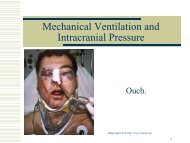Implementing Neuroscience Principles to Support Habilitation and ...
Implementing Neuroscience Principles to Support Habilitation and ...
Implementing Neuroscience Principles to Support Habilitation and ...
Create successful ePaper yourself
Turn your PDF publications into a flip-book with our unique Google optimized e-Paper software.
IMP~.EMENTING NEUKOSCIENCE PRINCIPI.ES TO SUPPOKT HARII.ITATION AND RECOVERY 201<br />
nate means for pressure maintenance in the middle ear.<br />
The cochlea is shaped like a snail with several chambers<br />
inside. The movement of the fluid within these chambers<br />
allows displacement of the hair cells. When the hair cells are<br />
displaced, the audi<strong>to</strong>ry nerves fire. Specific hair cells are<br />
responsible for specific sounds, <strong>and</strong> fire specific nerve cells.<br />
This process is known as <strong>to</strong>rw<strong>to</strong>pic organization <strong>and</strong> is the<br />
mechanism by which the CNS can identify the sounds heard.<br />
The central connections of the audi<strong>to</strong>ry system are<br />
unique in comparison <strong>to</strong> other sensory systems. Figure 8-7<br />
illustrates the audi<strong>to</strong>ry pathways. The ascending pathways of<br />
the audi<strong>to</strong>ry system are bilateral in nature: this is significant<br />
because loss of the input on one side will not completely s<strong>to</strong>p<br />
the information processing <strong>to</strong> both sides of the brain. In<br />
terms of functional performance, the individual experiences<br />
inability <strong>to</strong> localize sounds from the environment with loss of<br />
hearing <strong>to</strong> one ear or audi<strong>to</strong>ry nerve. Under normal conditions,<br />
the brain is able <strong>to</strong> compare the loudness of the sounds<br />
from the two ears <strong>to</strong> determine from which direction the<br />
sound is coming. When one ear has lost its ability <strong>to</strong> transmit<br />
information, the brain no longer can locate the direction,<br />
hence the person can hear the sound clearly, but has more difficulty<br />
finding it. Clinically, these individuals respond <strong>to</strong><br />
sounds by changing posture or looking around <strong>to</strong> search for<br />
the origin of the sound.<br />
These bilateral connections in the ascending audi<strong>to</strong>ry<br />
system extend throughout the brain stem. The inferior colliculus<br />
is a major relay point for audi<strong>to</strong>ry fibers (remember it<br />
is in the midbrain <strong>and</strong> is part of the tectum as described in the<br />
visual section). The inferior colliculus functions <strong>to</strong> alert the<br />
individual <strong>to</strong> audi<strong>to</strong>ry stimuli in the environment. From the<br />
brain stem, information travels <strong>to</strong> the medical geniculate<br />
body (in the thalamus) <strong>and</strong> the temporal lobe.<br />
The audi<strong>to</strong>ry system also has a feedback mechanism that<br />
performs an important function. This feedback system follows<br />
a similar course as the ascending pathways but in a<br />
more unilateral pattern. This fiber pathway inhibits hair cells<br />
carrying extraneous or unimportant background noise from<br />
the environment, thus allowing the individual <strong>to</strong> attend <strong>to</strong><br />
important sounds. This process is called audi<strong>to</strong>ry figureground<br />
perception. This is the mechanism which allows students<br />
<strong>to</strong> filter out such noises as rustling paper <strong>and</strong> shuffling<br />
feet in the classroom so they can hear the teacher's voice<br />
more clearly.<br />
Audi<strong>to</strong>ry System Intervention Approaches<br />
Although other professions may test the audi<strong>to</strong>ry system<br />
in more detail <strong>and</strong> may work on specific audi<strong>to</strong>ry components<br />
in their intervention plans, the occupational therapist is<br />
responsible for the effects of audi<strong>to</strong>ry deficits on task performance.<br />
Therapists must decide whether intervention should<br />
be set up in a quiet isolated place <strong>to</strong> avoid noisy environ-<br />
Medial<br />
geniculate<br />
Figure 8-7. Schematic diagram of the audi<strong>to</strong>ry pathways.<br />
ments <strong>and</strong> decrease the amount of effort required by the audi<strong>to</strong>ry<br />
system or in a more natural environment in which the<br />
individual must develop inhibi<strong>to</strong>ry skills. Both choices are<br />
therapeutically sound, but must be actively chosen as part of<br />
the intervention goals. For example, the therapist may choose<br />
<strong>to</strong> work in quiet environments early in the intervention<br />
process so that other areas of concern such as postural control<br />
can be addressed without competition. The therapist<br />
might choose a simpler postural task while working in a<br />
more competing audi<strong>to</strong>ry environment <strong>to</strong> help the individual<br />
learn <strong>to</strong> screen out the extraneous noises that will always be<br />
part of the natural environment. A portable tape recorder <strong>and</strong><br />
earphones are helpful <strong>to</strong> introduce controlled audi<strong>to</strong>ry stimuli,<br />
which can later be incorporated in<strong>to</strong> other activities. The<br />
therapist can control the type of sound (e.g.. clinic noise,<br />
classroom noise, neighborhood noise, music, talking) <strong>and</strong> the<br />
volume on the tape so that as the client adjusts <strong>to</strong> one condi-





